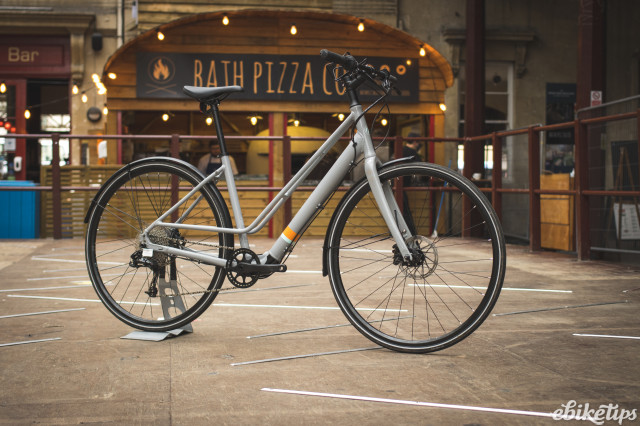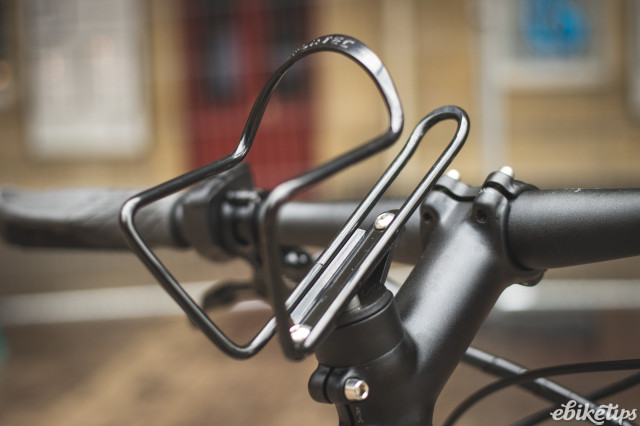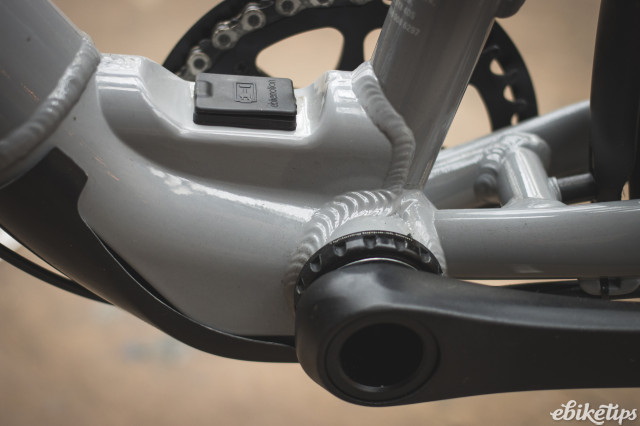Islabikes e-Janis
Overview
- Very good riding range
- Comfortable, upright riding position
- Easy-change tyres
- Hard-to-see power levels on the iWoc control
- I'd have liked handlebar grips with bar-ends
- Insufficient torque for very steep hills
Islabikes has long been one of the biggest and best names in children's bikes but more recently has branched out into bikes for a different market – those of us of more advanced years. Isla's two e-bikes have names designed to appeal to the pensioner (or near-pensioner, I'm not quite that old). The eJimi is Isla's electric mountain bike, while I've been taking Isla's flat-barred eJanis road bike for a spin around the byways, highways and hills of Bath.
Both the eJimi and eJanis are unisex machines based around step-through frames that back in the day would have been called a 'mixte'. Unlike the Ribble CGR we tested recently the dropped top-tube is split in two. These twin narrow tubes sit over a large-diameter main tube that provides rigidity and houses the battery. At 62mm in diameter, the tube is not that massive and doesn't instantly shout electric bike.
The eJanis and Ribble also share the same 250Wh Panasonic battery and MAHLE ebikemotion X35 36V/250Wh rear hub-mounted motor, which delivers 40Nm of torque. MAHLE's technology is used by many of the biggest names in cycling so spares should be available in the long-term.
Islabikes advertises the Janis as having a 40- to 50-mile range and I found this accurate. The longest ride I managed on a full charge was just under 80 kilometres (50 miles), but this included over 400m of climbing; it's difficult finding flat routes where I live. There are so many variables when it comes to range: weight, fitness, riding style, ambient temperature, wind and local topography can all affect the battery life.
I put down the eJanis's slightly lower range than the Ribble's to the eJanis's more upright and less aerodynamic riding position. I also found the speed the eJanis was most comfortable at was slightly slower, around 18kph or so. The upright riding position, while perhaps lowering range, does maximise your riding comfort. It offers great visibility in traffic – both seeing and being seen – while putting no pressure on your lower back, shoulders or arms.
The low step-through allows you to remount the bike easily and the eJanis is also compatible with a dropper post. This lets you drop the seatpost to ease getting off and on again, and could be a real boon if you have hip or knee issues.
The eJanis's electrical assistance is controlled by the iWoc TRIO remote control inside the left handlebar grip. You can switch between three power levels, though the light that shows you what power level you've chosen is hard to see in bright daylight. The iWoc also acts as a battery indicator: white for 75 per cent capacity, green for 50-75 per cent down to a rapid red flash when there's less than 10 per cent charge left.
Just as with the Ribble, Isla's MAHLE system senses your pedal motion very quickly with the assistance there almost instantaneously. It helps you to develop a smooth cycling style to keep the motor assisting you, encouraging gentle acceleration rather than cranking it up. The motor does carry on briefly when you stop pedalling, so you need to ease off fractionally earlier than usual at junctions, but this is something you quickly get used to. As with all UK e-bikes – in theory – the electrical assistance cuts off at around 25kph.
Power level 1 is for riding on the flat and gentle slopes, I used power level 2 for moderate slopes from three to five per cent or so and level 3 above six per cent. As with the Ribble the 40Nm motor lacks sufficient torque for climbs steeper than around 10 per cent, when your legs will end up doing more of the work. If your local riding takes in ascents this challenging, you really will need to look for a mid-motor e-bike with more torque.
The wheels and tyres are Islabikes' own and are a good pairing. They're not tubeless compatible, as Isla has designed them specifically to make them easier to remove and replace if your hands aren't as strong as they used to be, so they have a deeper well and a sloped internal rim wall for easier tyre changes.
The 30mm tyre width has a big enough volume of air for good comfort but without carrying too much speed-stealing weight; they coped with gentle towpath and non-gnarly woodland tracks too. Without mudguards the eJanis will accommodate 40mm tyres such as Isla's own 'Mixte' tyre. Designed for towpaths, tracks and gravel as well as tarmac, they cost £62.99 for a pair of tyres and tubes and will work with Mudhugger mudguards.
In spite of having hydraulic brakes the eJanis's frame and fork have dropouts rather than thru-axles. The front has a quick-release lever, while the rear axle is released using an 8mm hex bolt, so you'll need to carry a tool that allows you to get enough torque to secure it tightly if you puncture. The cable from the battery to the motor splits along the chainstay, to allow you to remove the wheel.
The lack of thru-axles didn't seem to hamper the braking. SRAM's Level TL dual-piston hydraulic disc brakes don't require you to grab a fistful of brake lever to achieve smooth, super-powerful and controlled braking. Their light action is a boon for less strong – I hate to use the word 'weaker' – hands.
The SRAM gearing pairs a single 34T chainring with an 11-40 cassette. This results in a low 23in bottom gear akin to that of a touring bike's with the inevitable trade-off at the top end of the gear range. But a low bottom gear is nearly always more important than a high top gear – even more so in an electric bike designed for the older rider. Light-action shifting is delivered by a grip-shift operated by your right hand. Isla's single-ring setup also allows for a low Q-factor – the distance between the pedals – for more comfortable cycling.
One final way in which the Janis impressed me is how well it rides without the electrical assistance. There will always be some drag from the motor – you cannae change the laws of physics, after all, and there's no such thing as free energy – but the Janis rides much like any other hybrid bike, helped by the low bottom gear.
Islabikes markets the e-Janis as a bike for the pension-age rider. But if you're looking for an upright, step-through e-bike with a comfortable ride and well-considered kit, whatever your age, I'd suggest taking it for an electrically assisted spin. The flat handlebar and low-slung step-through frame make for a comfortable, upright riding position and a bike that's easy to mount. It has powerful and controlled braking with very little hand-or-finger effort, and a good range of easy-to-operate gears. The wheel and tyre pairing makes tyre changes easier and the electrical assistance is quick to start and simple to control. It's a lovely ride, and easy to recommend for city riding and beyond.































